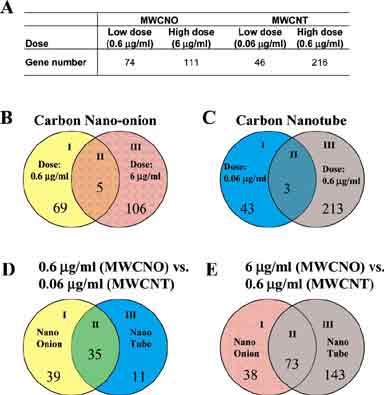Data Gathered using Berkeley Lab’s Nanotoxicity Methodology

(A) Numbers of genes whose expression levels changed after treatment with carbon nanomaterials at cytotoxic doses. (B-E) Venn diagrams comparing numbers of genes that showed expression changes. See the publication located at this link for more information on this image.
APPLICATIONS:
- High throughput and high content nanotoxicity screening
- Discovering new nanotoxicology profiles and new targets for nanotherapy
- Nanomaterial toxigenomics and high content imaging analysis
ADVANTAGES :
- Minimizes the need for expensive and controversial animal studies
- Enables rapid screening and classification of nanomaterials
- Provides a comprehensive in vitro screening platform for nanomaterials with high sensitivity and high biological resolution
- Provides a set of comprehensive nanotoxicology tools, including biomarkers, and a reliable nanotoxicology methodology
- Identifies which negative biological effects can be attenuated and which cannot
DESCRIPTION:
Fanqing Chen of Berkeley Lab has developed a comprehensive and validated methodology for measuring toxicological hazards associated with exposure to nanomaterials. The invention employs expression array analysis and high content image-analysis based phenotype measurements to reliably predict adverse health effects from nanomaterials in vivo. The invention minimizes the need for animal studies and provides a rational methodology and tools for rapid toxicity screening, toxigenomics and toxicology profile discovery. It also enables the user to identify negative effects that lend themselves to attenuation and those that do not.
Dr. Chen has established biomarkers and specific gene expression patterns in response to various nanoparticles/nanomaterials in the biological pathways of inflammation, apoptosis, immune response, ubiquitination, cell proliferation, cell cycle regulation, cell differentiation, golgi vesicle transport, membrane fusion, secretory pathway, intracellular transport, nucleocytoplasmic transport, response to DNA damage, and response to stress and stimuli. His quantitative matrix includes the key factors that have been determined to contribute to nanomaterial-related cytotoxicology such as concentration, size/mass, shape, surface charge, surface functionalization, and surface coating.
STATUS: Issued U. S. Patent #8,785,505. Available for licensing or collaborative research.
FOR MORE INFORMATION SEE:
REFERENCE NUMBER: IB-2218b
SEE THESE OTHER BERKELEY LAB TECHNOLOGIES IN THIS FIELD:
- Nano-onion Therapy for Cancer Tumors

- Nanocrystals:
- Nanotubes: